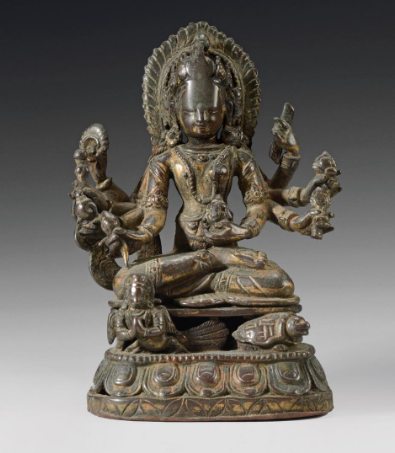Details
- Title : VAIKUNTA-KAMALAJA
- Year : 17th Century
- Classification : Sculpture
- Medium : Gilt-bronze
- Dimension : Height 5 in. (12.8 cm.)
- Accession No : GNM_LOT 90_PUN_05
- Country/ Geo-location : Nepal
- Collection : PUNDOLE’S
- Status : LIVE AUCTION The Art of the Himalayas from the Collection of Roshan Sabavala (M0009) (As per NOV 2021)
- ESTIMATED : ₹200,000 - ₹300,000
- SOLD : ₹240,000
- NOTE : Vaikuntha-Kamalaja, a composite androgynous form of the Hindu deities Vishnu and Lakshmi, is seated on a lotus pedestal supported by their respective vahanas, Garuda and Kurma. The left half of the figure with a prominent bosom is female, and signifies Lakshmi, whilst the right half signifies Vishnu. The male half holds in his right hands the attributes associated with Vishnu, the discus, mace, conch and lotus. In the left hands the deity holds the attributes associated with the Devi, a water pot filled with gems, a mirror, a lotus and a manuscript. The head is surmounted by a foliate crown and surrounded by a flaming nimbus. Vaikuntha-Kamalaja symbolises the non-duality of the male and female principles in the universe. The Shilparatna specifically refers to the oneness of Vishnu and Lakshmi as a combination of truth (sat) and consciousness (cit), which produces a state of bliss (ananda). The iconography of Vaikuntha-Kamalaja is rare and normally only seen in the sculptures of Nepal and Kashmir. Dr. Pal has suggested that the concept of Vaikuntha-Kamalaja originated in Eastern India, but scholastic opinion remains divergent on the matter, citing both Nepal and Kashmir as alternative birthplaces for the iconographic form. The earliest known Nepalese depictions of the composite form appear in the 13th century, so the iconography was well established by the time the current example was created.
